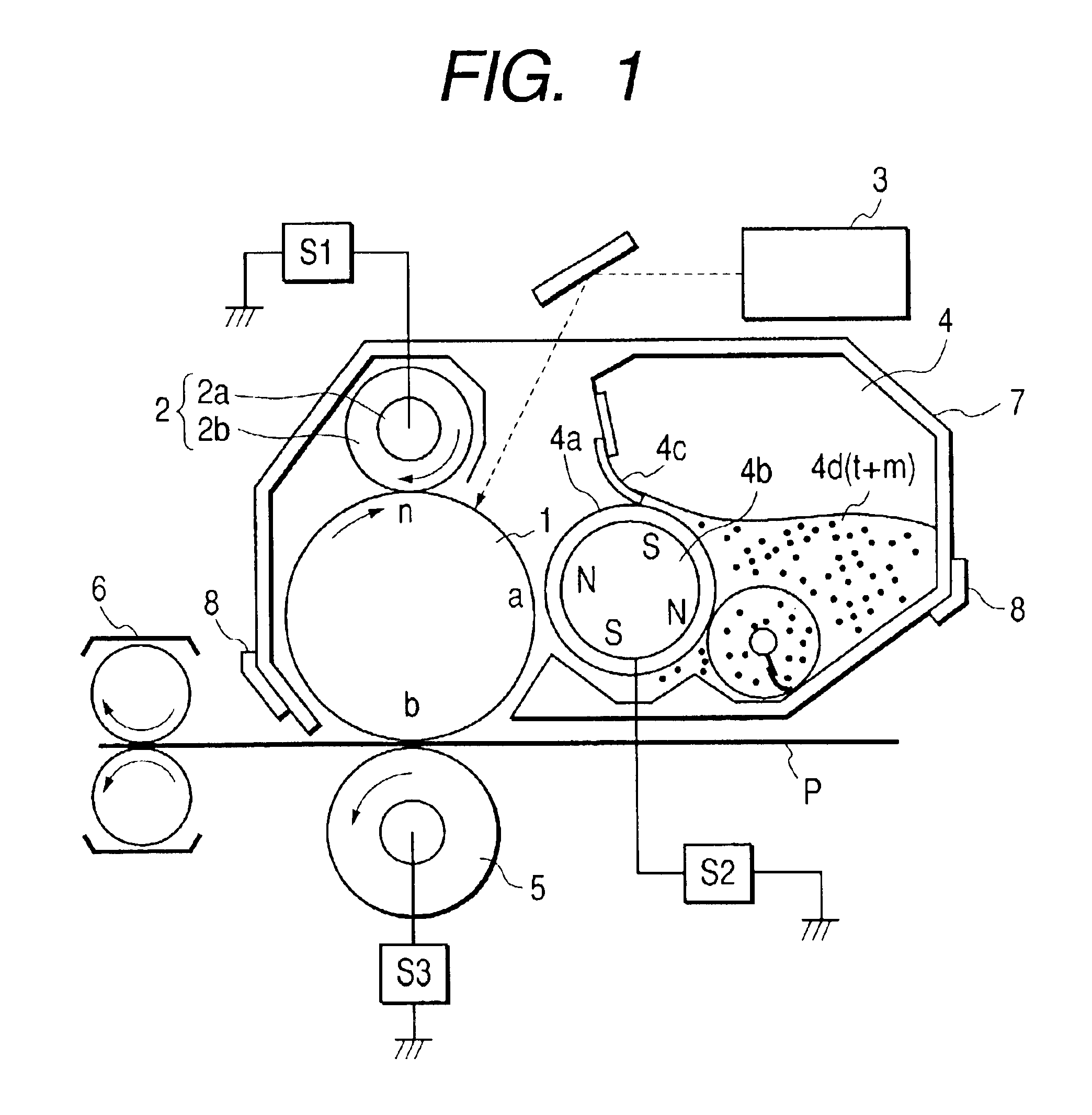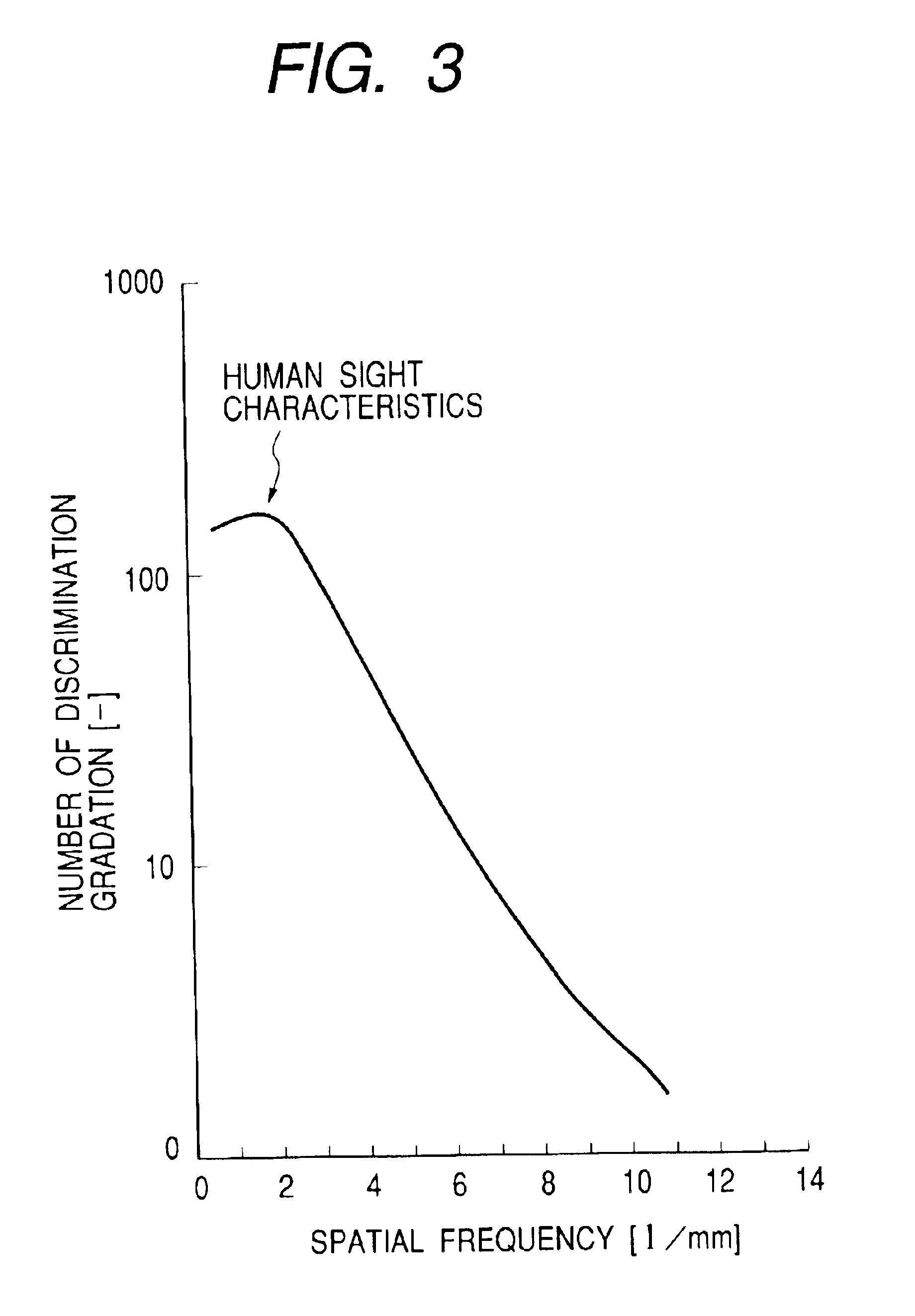Hence, any attempt to perform direct-injection charging may inevitably cause a decrease in absolute chargeability, a contact unevenness due to a shortage in contact performance and roller shape and a charging unevenness due to any deposits on the charging object member.
In DC charging, however, it has been difficult to control the potential of the photosensitive member at the desired value because the resistance value of the contact charging member varies depending on environmental variations and also because the Vth varies with changes in
layer thickness caused by the abrasion of the photosensitive member.
When the AC charging is performed in order to achieve uniform charging,
ozone may be generated, the
electric field generated by AC
voltage may cause a vibrating
noise (AC charging sound) between the contact charging member and the photosensitive member, and any discharging may remarkably cause deterioration or the like of the surface of the photosensitive member.
Those having a
fiber density of about 100 fibers / mm2 are obtained relatively with ease, but are still insufficient for contact performance in order to perform well uniform charging by direct-injection charging.
In order to well perform uniform charging by direct-injection charging, the fur
brush charging assembly must be made to have a velocity different from that of the photosensitive member; the difference is so large as to make
machine construction difficult.
This is not realistic.
Magnetic-
brush charging, however, may also cause a difficulty that the conductive magnetic particles constituting the magnetic-
brush portion come off to adhere to the photosensitive member.
There, however, has been a problem that pressing a cleaning member against the latent-image-bearing member surface causes the latent-image-bearing member to wear to make the latent-image-bearing member have a
short lifetime.
This has been a
bottleneck in attempts to make the apparatus compact.
In this sense, such techniques have not been satisfactory for various
recording media.
However, in the cleaning-at-development or cleanerless process making use of a contact development
system, its long-term service tends to cause deterioration of toner, deterioration of the toner-carrying member surface and deterioration or wear of the latent-image-bearing member surface, but any satisfactory solution has not been made for running performance.
However, where the transfer residual toner has adhered to or mingled with the contact charging member beyond the contact charging member's capacity to control toner's charge polarity, it becomes impossible to uniformly adjust the charge polarity of the transfer residual toner, making it difficult to collect the toner in the step of development.
Also, even where the transfer residual toner has been collected on the toner-carrying member by
mechanical force such as
rubbing, the transfer residual toner may adversely affect the triboelectric chargeability of toner on the toner-carrying member, resulting in a lowering of developing performance, unless the charge of the transfer residual toner has not uniformly been adjusted.
However, the contact charging used here also applies the
discharge charging mechanism, which is not the direct injection charging mechanism, and has the above problem ascribable to
discharge charging.
Moreover, these proposals may be effective for keeping the charging performance of the contact charging member from decreasing because of the transfer residual toner, but can not be expected to be effective for actively improving the charging performance.
Such image-forming apparatus have good cleaning-at-development performance and the waste toner can sharply be reduced, but involve a high cost and may adversely affect the
advantage inherent in the cleaning-at-development
system also in view of compact construction.
Accordingly, when the apparatus is used over a long period of time, difficulties, such as smeared images due to
ozone products, tend to come out.
Moreover, when the above construction is applied in cleanerless image-forming apparatus, any inclusion of the transfer residual toner makes it difficult for the coated
powder, to stand adhered uniformly to the charging member, so that the effect of carrying out uniform charging may decrease.
However, the contact charging used here, or proximity charging, applies the
discharge charging mechanism, which is not the direct injection charging mechanism, and has the above problem ascribable to discharge charging.
Moreover, when this construction is applied in the cleanerless image-forming apparatus, the influence on charging performance of a larger quantity of conductive fine particles and transfer residual toner in the charging step than the apparatus having a cleaning mechanism, the influence on the collection of these large-quantity conductive fine particles and transfer residual toner in the developing step, and the influence on the developer's developing performance that is exercised by the conductive fine particles and transfer residual toner thus collected, is not addressed.
Furthermore, when the direct injection charging mechanism is applied in the contact charging, the conductive fine particles can not be fed to the contact charging member in the necessary quantity, thereby causing faulty charging due to the influence of the transfer residual toner.
In proximity charging, it is also difficult to uniformly charge the photosensitive member because of the large-quantity conductive fine particles and transfer residual toner, and the effect of leveling patterns of the transfer residual toner cannot be obtained, to cause a pattern ghost because the transfer residual toner may shut out pattern-imagewise
exposure light.
In-machine
contamination due to developer may further occur when a power source is instantaneously turned off or a paper jam occurs during
image formation.
Thus, with respect to developers for use in the image-forming method having the step of injection charging or in the image-forming method having the step of cleaning-at-development or in the cleanerless image-forming method, sufficient studies have not been made on external additives.
With respect to proposals on developers, inclusive of those on external additives, sufficient studies have also not been made to adapt to the cleaning-at-development image-forming method or the cleanerless image-forming method.
The collection performance on transfer residual toner in the cleaning-at-development
system commonly tends to decrease with an increase in the process speed.
The reasons for this are that making the process speed higher makes it difficult to
well control the charging of transfer residual toner in primary charging, which tends to result in non-uniform charging of the transfer residual toner sent out from primary charging and directed to the collection at development, and that it tends to become difficult to keep the triboelectric chargeability of developer from being influenced by the inclusion of the transfer residual toner collected at development.
The charging performance in direct-injection charging also tends to decrease with an increase in process speed.
Moreover, where the ratio of the charging member movement speed to the image-bearing member movement speed is maintained or made higher with an increase in process speed, a great increase in torque may cause a cost increase, and the problem of in-machine
contamination tends to occur, which is caused by any scratches of the image-bearing member and the charging member and any scattering of transfer residual toner adhering to or mingling with the charging member.
 Login to View More
Login to View More  Login to View More
Login to View More 


